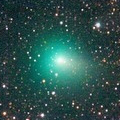
|
It brightened rapidly in December. Now it is bright as 8.9 mag (Apr. 12, Carlos Labordena). It stays observable at 9 mag in excellent condition in April.
Date(TT) R.A. (2000) Decl. Delta r Elong. m1 Best Time(A, h)
Apr. 17 17 59.88 17 7.7 0.520 1.280 110 8.7 3:56 (341, 71)
Apr. 24 16 4.21 29 9.8 0.464 1.348 129 8.8 2:02 ( 0, 84)
|
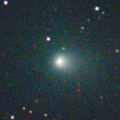
|
It brightened rapidly. Now it is very bright as 11.3 mag (Apr. 12, Carlos Labordena). It stays observable at 11 mag in good condition for a long time from spring to summer.
Date(TT) R.A. (2000) Decl. Delta r Elong. m1 Best Time(A, h)
Apr. 17 13 55.00 34 7.6 1.463 2.289 135 11.6 0:16 ( 0, 89)
Apr. 24 13 50.36 33 27.6 1.440 2.254 133 11.4 23:39 ( 0, 88)
|
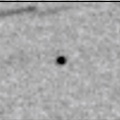
|
Now it is 10.8 mag (Apr. 10, Chris Wyatt). Appearing in the morning sky in the Southern Hemisphere. In the Northern Hemisphere, it will appear in the morning sky in June.
Date(TT) R.A. (2000) Decl. Delta r Elong. m1 Best Time(A, h)
Apr. 17 23 41.05 -6 44.2 2.150 1.435 34 11.7 3:56 (275, -5)
Apr. 24 0 2.34 -5 6.8 2.144 1.449 35 11.8 3:46 (273, -5)
|
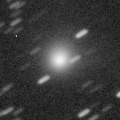
|
Now it is 13.0 mag (Mar. 31, Thomas Lehmann). It will brighten up to 10 mag in winter in 2022. In the Northern Hemisphere, it stays observable in good condition for a long time, although it becomes extremely low temporarily from May to June. In the Southern Hemisphere, it is not observable until November.
Date(TT) R.A. (2000) Decl. Delta r Elong. m1 Best Time(A, h)
Apr. 17 2 49.65 50 54.0 4.969 4.290 42 12.8 20:03 (140, 19)
Apr. 24 3 2.93 50 49.1 4.980 4.256 39 12.8 20:10 (142, 16)
|

|
It brightened up to 10.5 mag in early March (Mar. 8, Bob King). Now it is fading. But it is still bright as 12.6 mag (Apr. 4, Sandor Szabo). In the Northern Hemisphere, it stays observable in the evening low sky until early June while the comet will be fading. It is not observable in the Southern Hemisphere.
Date(TT) R.A. (2000) Decl. Delta r Elong. m1 Best Time(A, h)
Apr. 17 3 42.98 34 5.3 1.884 1.236 36 12.8 20:03 (119, 19)
Apr. 24 4 18.54 34 19.3 1.974 1.317 36 13.2 20:10 (119, 19)
|
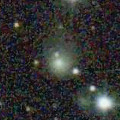
|
Now it is 13.9 mag (Apr. 12, Chris Wyatt). It is expected to be observable at 5-6 mag for a long time from 2022 to 2023. In the Northern Hemisphere, it is not observable at the high light from 2022 summer to 2023 summer. In the Southern Hemisphere, it stays extremely low for a while. But it will be observable in good condition at the high light.
Date(TT) R.A. (2000) Decl. Delta r Elong. m1 Best Time(A, h)
Apr. 17 18 26.11 40 51.0 6.405 6.598 96 13.2 3:56 (235, 79)
Apr. 24 18 24.06 41 27.2 6.297 6.542 99 13.2 3:46 (221, 81)
|
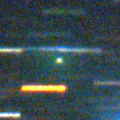
|
Now it is 13.5 mag (Mar. 28, Thomas Lehmann). Brightenening very rapidly. It will brighten up to 11 mag from May to August. In the Southern Hemisphere, it stays observable in excellent condition for a long time. In the Northern Hemisphere, it stays observable in good condition for a while. But it becomes extremely low after July.
Date(TT) R.A. (2000) Decl. Delta r Elong. m1 Best Time(A, h)
Apr. 17 18 42.48 7 17.0 0.678 1.328 102 13.5 3:56 (328, 59)
Apr. 24 19 6.49 5 53.4 0.626 1.300 103 13.2 3:46 (326, 57)
|
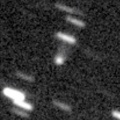
|
Now it is 14.8 mag (Apr. 12, Chris Wyatt). It is expected to brighten up to 13 mag from spring to summer. But actually, it is fainter than this ephemeris recently. In the Southern Hemisphere, it stays observable in good condition for a long time. In the Northern Hemisphere, it is not observable until July in 2022.
Date(TT) R.A. (2000) Decl. Delta r Elong. m1 Best Time(A, h)
Apr. 17 19 45.44 -70 28.7 3.347 3.647 99 13.2 3:56 (349,-18)
Apr. 24 20 3.16 -72 10.9 3.286 3.637 102 13.2 3:46 (350,-19)
|

|
It brightened up to 11.6 mag in winter (Feb. 18, Thomas Lehmann). Now it is fading. It has already faded down to 14.2 mag (Apr. 12, Chris Wyatt). In the Southern Hemisphere, it stays observable in good condition after this. In the Northern Hemisphere, it will never be observable after this.
Date(TT) R.A. (2000) Decl. Delta r Elong. m1 Best Time(A, h)
Apr. 17 4 4.21 -62 26.0 2.431 2.429 77 13.2 20:03 ( 32,-28)
Apr. 24 4 12.70 -60 5.3 2.511 2.489 77 13.4 20:10 ( 36,-31)
|
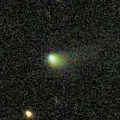
|
Now it is 15.1 mag (Apr. 12, Chris Wyatt). It stays 13-14 mag from 2020 to 2021. It will be observable in good condition after this in the Southern Hemisphere. It locates somewhat low in the Northern Hemisphere.
Date(TT) R.A. (2000) Decl. Delta r Elong. m1 Best Time(A, h)
Apr. 17 19 15.44 -24 59.4 2.532 2.878 99 13.8 3:56 (335, 26)
Apr. 24 19 20.55 -25 27.1 2.445 2.883 105 13.8 3:46 (338, 26)
|
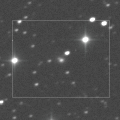
|
Now it is 13.2 mag (Apr. 12, Chris Wyatt). It stays 13.5 mag until early summer. In the Southern Hemisphere, it stays observable in good condition for a long time. It is getting higher slowly also in the Northern Hemisphere.
Date(TT) R.A. (2000) Decl. Delta r Elong. m1 Best Time(A, h)
Apr. 17 16 44.54 -36 56.9 2.613 3.355 130 13.8 3:06 ( 0, 18)
Apr. 24 16 27.18 -35 43.5 2.515 3.356 140 13.8 2:21 ( 0, 19)
|
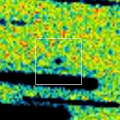
|
It was expected to brighten up to 13 mag from spring to summer. But actually, now it is extremely faint as 19.0 mag (Mar. 22, A. C. Gilmore, P. M. Kilmartin). In the Southern Hemisphere, it stays observable in good condition for a long time. In the Northern Hemisphere, it is not observable until late August.
Date(TT) R.A. (2000) Decl. Delta r Elong. m1 Best Time(A, h)
Apr. 17 22 27.70 -42 59.6 1.755 1.681 69 14.0 3:56 (314,-12)
Apr. 24 23 5.11 -44 40.4 1.678 1.644 70 13.8 3:46 (314,-16)
|
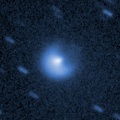
|
Now it is 13.2 mag (Mar. 6, Thomas Lehmann). It is already unobservable in the Southern Hemisphere. It will be unobservable soon also in the Northern Hemisphere.
Date(TT) R.A. (2000) Decl. Delta r Elong. m1 Best Time(A, h)
Apr. 17 3 7.51 25 47.1 6.760 5.873 25 13.9 20:03 (116, 8)
Apr. 24 3 13.41 26 5.3 6.804 5.874 20 13.9 20:10 (121, 2)
|
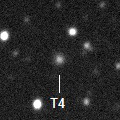
|
Now it is 14.1 mag (Apr. 12, Chris Wyatt). It is expected to brighten up to 11.5 mag in 2022. It is observable in excellent condition in the Southern Hemisphere. In the Northern Hemisphere, it is observable in the low sky until May.
Date(TT) R.A. (2000) Decl. Delta r Elong. m1 Best Time(A, h)
Apr. 17 8 4.16 -31 13.0 5.166 5.439 100 14.3 20:03 ( 23, 20)
Apr. 24 8 7.13 -30 10.3 5.196 5.405 96 14.3 20:10 ( 30, 18)
|

|
It has not been observed yet in this apparition. It will brighten up to 10 mag from summer to autumn, and it will be observable in excellent condition. Appearing in the morning sky.
Date(TT) R.A. (2000) Decl. Delta r Elong. m1 Best Time(A, h)
Apr. 17 23 4.15 -1 20.8 2.815 2.153 40 14.7 3:56 (276, 6)
Apr. 24 23 18.71 0 2.8 2.727 2.112 43 14.5 3:46 (275, 7)
|
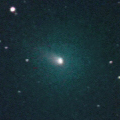
|
It brightening very rapidly up to 12.5 mag in early February (Feb. 8, Michael Jager). Now it is fading. It has already faded down to 14.9 mag (Apr. 12, Chris Wyatt). In the Southern Hemisphere, it stays observable after this while the comet will be fading. It is not observable after this in the Northern Hemisphere.
Date(TT) R.A. (2000) Decl. Delta r Elong. m1 Best Time(A, h)
Apr. 17 4 12.81 -12 4.7 1.730 1.227 44 14.7 20:03 ( 76, -1)
Apr. 24 4 13.85 -13 48.9 1.838 1.270 41 15.5 20:10 ( 80, -9)
|

|
It will brighten up to 14.5 mag from spring to summer. In the Southern Hemisphere, it stays observable in excellent condition for a long time. In the Northern Hemisphere, it is not observable after this.
Date(TT) R.A. (2000) Decl. Delta r Elong. m1 Best Time(A, h)
Apr. 17 0 3.03 -50 43.1 2.917 2.647 64 15.0 3:56 (313,-30)
Apr. 24 0 21.21 -52 54.0 2.826 2.646 69 14.9 3:46 (315,-31)
|
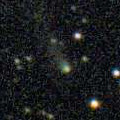
|
Now it is 14.7 mag (Mar. 12, D. Buczynski). It will stay at 14-15 mag for a long time from 2021 to 2022. It stays observable in good condition after this while brightening gradually.
Date(TT) R.A. (2000) Decl. Delta r Elong. m1 Best Time(A, h)
Apr. 17 18 16.16 1 19.2 4.790 5.224 110 15.1 3:56 (342, 55)
Apr. 24 18 12.40 1 2.4 4.669 5.208 117 15.0 3:46 (351, 56)
|

|
Now it is 15.3 mag (Apr. 12, Chris Wyatt). It stays 14-15 mag until the end of 2021. In the Southern Hemisphere, it stays observable in good condition for a long time. In the Northern Hemisphere, it is not observable until June.
Date(TT) R.A. (2000) Decl. Delta r Elong. m1 Best Time(A, h)
Apr. 17 23 9.56 -38 59.2 4.736 4.330 60 15.0 3:56 (306,-17)
Apr. 24 23 15.79 -38 13.8 4.667 4.333 64 15.0 3:46 (307,-14)
|

|
Now it is 15.6 mag (Apr. 12, Chris Wyatt). It stays 15 mag until summer. In the Southern Hemisphere, it stays observable in good condition until June. In the Northern Hemisphere, it is observable in the low sky from March to May.
Date(TT) R.A. (2000) Decl. Delta r Elong. m1 Best Time(A, h)
Apr. 17 6 46.12 -23 33.9 2.152 2.246 82 15.2 20:03 ( 43, 18)
Apr. 24 6 56.90 -19 27.9 2.175 2.207 78 15.1 20:10 ( 50, 17)
|

|
Now it is 15.2 mag (Mar. 24, F. Kugel, J.-G. Bosch). It will brighten up to 13 mag in 2022. In 2021, it is observable at 15-16 mag in good condition.
Date(TT) R.A. (2000) Decl. Delta r Elong. m1 Best Time(A, h)
Apr. 17 13 19.98 -0 29.1 2.682 3.672 168 15.3 23:36 ( 0, 54)
Apr. 24 13 15.35 -0 14.1 2.686 3.657 162 15.3 23:04 ( 0, 55)
|

|
It brightened up to 5.6 mag in early December (Dec. 9, Marco Goiato). In mid December, it was visible at about 3 mag in the SOHO spacecraft images (Dec. 18, Hirohisa Sato). Appearing in the morning sky.
Date(TT) R.A. (2000) Decl. Delta r Elong. m1 Best Time(A, h)
Apr. 17 23 34.73 10 51.1 3.223 2.415 30 15.4 3:56 (261, 7)
Apr. 24 23 42.65 11 54.5 3.271 2.514 35 15.6 3:46 (262, 9)
|

|
Now it is 15.8 mag (Jan. 16, Slooh.com Canary Islands Observatory). It is not observable until June.
Date(TT) R.A. (2000) Decl. Delta r Elong. m1 Best Time(A, h)
Apr. 17 0 45.47 15 1.4 3.085 2.125 14 15.4 3:56 (248, -5)
Apr. 24 0 59.74 16 59.8 3.081 2.137 16 15.5 3:46 (247, -3)
|
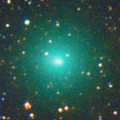
|
It brightened up to 8.2 mag in autumn (Oct. 13, Chris Wyatt). It faded down to 13.0 mag in February (Feb. 14, Sandor Szabo). It is not observable after this.
Date(TT) R.A. (2000) Decl. Delta r Elong. m1 Best Time(A, h)
Apr. 17 2 1.77 11 8.4 3.390 2.392 5 15.4 20:03 (115,-14)
Apr. 24 2 14.10 12 18.6 3.443 2.438 2 15.6 20:10 (119,-17)
|

|
It had been observed as 8-9 mag for a long time in 2020. Now it is fading. It has already faded down to 16.4 mag (Mar. 27, Thomas Lehmann). It will be observable in good condition after this in the Southern Hemisphere. It locates extremely low after this in the Northern Hemisphere.
Date(TT) R.A. (2000) Decl. Delta r Elong. m1 Best Time(A, h)
Apr. 17 17 41.21 -41 1.2 3.805 4.381 119 15.5 3:56 (359, 14)
Apr. 24 17 37.04 -42 0.5 3.781 4.446 125 15.5 3:30 ( 0, 13)
|
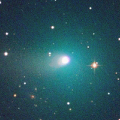
|
Brightened rapidly, and it brightened up to 9.7 mag in November (Nov. 15, Chris Wyatt). Now it is fading. It has already faded down to 14.9 mag (Apr. 4, Sandor Szabo). In the Northern Hemisphere, it stays observable in good condition for a long time. In the Southern Hemisphere, it locates extremely low after this.
Date(TT) R.A. (2000) Decl. Delta r Elong. m1 Best Time(A, h)
Apr. 17 6 25.63 39 29.6 2.227 2.091 69 15.5 20:03 (112, 51)
Apr. 24 6 43.83 38 51.0 2.342 2.142 66 15.7 20:10 (112, 47)
|

|
Now it is 16.4 mag (Mar. 30, Thomas Lehmann). In the Northern Hemisphere, it stays observable at 15 mag for a long time from spring to early 2022. In the Southern Hemisphere, it is not observable until the end of 2021.
Date(TT) R.A. (2000) Decl. Delta r Elong. m1 Best Time(A, h)
Apr. 17 20 5.63 69 12.5 3.303 3.247 78 15.8 3:56 (200, 50)
Apr. 24 19 51.50 72 14.6 3.259 3.222 78 15.7 3:46 (193, 50)
|
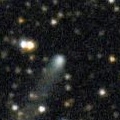
|
Now it is 15.4 mag (Mar. 16, Toshihiko Ikemura, Hirohisa Sato). It stays 15-16 mag until June. In the Northern Hemisphere, it stays observable in good condition for a long time. In the Southern Hemisphere, it will be observable in the extremely low sky only in next spring.
Date(TT) R.A. (2000) Decl. Delta r Elong. m1 Best Time(A, h)
Apr. 17 19 16.53 44 28.3 5.054 5.099 86 15.7 3:56 (236, 69)
Apr. 24 19 12.51 46 23.3 5.030 5.125 89 15.7 3:46 (227, 71)
|

|
It has not been observed yet in this apparition. The condition of this apparition is bad. It brightens up to 15.5 mag in spring, however, it is not observable until autumn when it becomes fainter than 19 mag.
Date(TT) R.A. (2000) Decl. Delta r Elong. m1 Best Time(A, h)
Apr. 17 1 37.12 10 28.7 2.315 1.312 0 16.1 3:56 (243,-17)
Apr. 24 2 0.51 12 58.9 2.288 1.283 1 15.9 3:46 (240,-17)
|

|
It brightened up to 10.5 mag in early February (Feb. 6, Marco Goiato). Now it is fading rapidly. It has already faded down to 15.7 mag (Apr. 4, Sandor Szabo). In the Northern Hemisphere, it stays observable for a long time after this. In the Southern Heimsphere, it will never be observable again.
Date(TT) R.A. (2000) Decl. Delta r Elong. m1 Best Time(A, h)
Apr. 17 5 5.92 52 26.7 2.150 1.845 58 16.0 20:03 (133, 39)
Apr. 24 5 11.11 53 47.2 2.300 1.906 54 16.4 20:10 (136, 35)
|

|
Now it is 16.0 mag (Apr. 4, Michael Jager). It is expected to brighten up to 13 mag in 2022. In the Southern Hemisphere, it stays observable in good condition for a long time. In the Northern Hemisphere, it stays observable until June, but it will not be observable at the high light.
Date(TT) R.A. (2000) Decl. Delta r Elong. m1 Best Time(A, h)
Apr. 17 13 8.62 -20 53.7 4.045 5.028 167 16.0 23:25 ( 0, 34)
Apr. 24 12 59.82 -20 54.7 4.015 4.982 162 16.0 22:48 ( 0, 34)
|

|
Now it is 15.2 mag (Mar. 30, Thomas Lehmann). In the Northern Hemisphere, it stays observable for a long time while it is getting fainter slowly. In the Southern Hemisphere, it will never be observable again.
Date(TT) R.A. (2000) Decl. Delta r Elong. m1 Best Time(A, h)
Apr. 17 15 14.95 69 42.2 5.452 5.683 98 16.3 1:35 (180, 55)
Apr. 24 14 59.11 69 33.7 5.518 5.731 97 16.3 0:52 (180, 56)
|
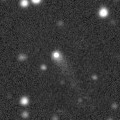
|
Now it is 15.7 mag (Apr. 4, Michael Jager). It stays observable at 16 mag from 2021 to 2022.
Date(TT) R.A. (2000) Decl. Delta r Elong. m1 Best Time(A, h)
Apr. 17 14 7.72 -15 26.1 3.890 4.885 171 16.3 0:29 ( 0, 39)
Apr. 24 14 3.17 -13 52.3 3.865 4.870 178 16.3 23:52 ( 0, 41)
|
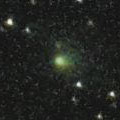
|
Now it is 15.5 mag (Apr. 5, Sandor Szabo). It stays observable at 16 mag in good condition from April to May.
Date(TT) R.A. (2000) Decl. Delta r Elong. m1 Best Time(A, h)
Apr. 17 14 37.31 14 0.9 1.432 2.365 151 16.4 0:59 ( 0, 69)
Apr. 24 14 7.11 12 21.0 1.419 2.368 154 16.4 0:02 ( 0, 67)
|

|
Now it is 16.7 mag (Mar. 14, Toshihiko Ikemura, Hirohisa Sato). It is observable at 16.5 mag from spring in 2020 to summer in 2021.
Date(TT) R.A. (2000) Decl. Delta r Elong. m1 Best Time(A, h)
Apr. 17 17 27.81 -14 19.3 4.174 4.812 124 16.5 3:48 ( 0, 41)
Apr. 24 17 20.51 -14 49.6 4.086 4.827 132 16.4 3:13 ( 0, 40)
|

|
Now it is 16.5 mag (Feb. 9, Toshihiko Ikemura, Hirohisa Sato). It is observable at 16 mag from 2020 to 2021. In the Southern Hemisphere, it is not observable until summer.
Date(TT) R.A. (2000) Decl. Delta r Elong. m1 Best Time(A, h)
Apr. 17 23 11.99 42 45.9 6.613 5.955 45 16.5 3:56 (235, 27)
Apr. 24 23 14.44 42 56.3 6.589 5.958 47 16.5 3:46 (236, 30)
|
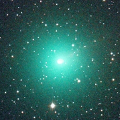
|
It brightened up to 7.3 mag in November (Nov. 7, Marco Goiato). Now it is fading. It has already faded down to 16.0 mag (Mar. 17, Toshihiko Ikemura, Hirohisa Sato). In the Northern Hemisphere, it stays observable in excellent condition for a long time. In the Southern Hemisphere, it stays locating extremely low after this.
Date(TT) R.A. (2000) Decl. Delta r Elong. m1 Best Time(A, h)
Apr. 17 7 34.87 43 6.2 2.610 2.663 82 16.5 20:03 (118, 64)
Apr. 24 7 46.90 42 18.8 2.763 2.736 77 16.8 20:10 (115, 60)
|
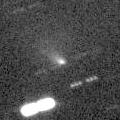
|
Now it is 16.5 mag (Mar. 30, Thomas Lehmann). It will be fading after this. In the Northern Hemisphere, it will be getting lower gradually, and will be too low to observe in May. In the Southern Hemisphere, it stays observable in good condition after this.
Date(TT) R.A. (2000) Decl. Delta r Elong. m1 Best Time(A, h)
Apr. 17 6 7.61 6 30.9 1.493 1.424 66 16.5 20:03 ( 73, 33)
Apr. 24 6 31.05 4 29.8 1.553 1.465 65 16.7 20:10 ( 73, 29)
|
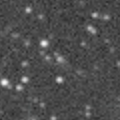
|
Now it is 16.5 mag (Feb. 11, Taras Prystavski). It will brighten up to 16.5 mag in summer.
Date(TT) R.A. (2000) Decl. Delta r Elong. m1 Best Time(A, h)
Apr. 17 17 34.54 -30 41.7 4.365 4.972 122 16.7 3:55 ( 0, 24)
Apr. 24 17 31.95 -29 52.1 4.260 4.961 129 16.6 3:25 ( 0, 25)
|

|
First return of a new periodic comet which brightened up to 14-15 mag in 2006. Now it is 14.8 mag (Apr. 4, Sandor Szabo). It will be fading rapidly after this, and it will be fainter than 18 mag in May.
Date(TT) R.A. (2000) Decl. Delta r Elong. m1 Best Time(A, h)
Apr. 17 13 17.34 21 44.0 1.027 1.950 147 16.6 23:34 ( 0, 77)
Apr. 24 13 16.45 21 47.5 1.083 1.983 143 16.9 23:06 ( 0, 77)
|
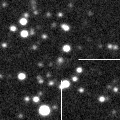
|
Now it is 16.2 mag (Mar. 16, Toshihiko Ikemura, Hirohisa Sato). It stays at 16-17 mag from 2020 to 2021. In the Northern Hemisphere, it stays observable in good condition for a long time. It locates extremely low in the Southern Hemisphere.
Date(TT) R.A. (2000) Decl. Delta r Elong. m1 Best Time(A, h)
Apr. 17 19 47.25 41 44.1 8.910 8.823 81 16.7 3:56 (245, 64)
Apr. 24 19 46.58 42 47.0 8.857 8.824 84 16.7 3:46 (242, 67)
|
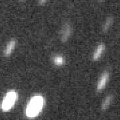
|
Now it is 17.0 mag (Apr. 1, Michael Jager). It is expected to brighten up to 11 mag in 2023. In the Northern Hemisphere, it stays observable in good condition for a long time. It locates extremely low in the Southern Hemisphere.
Date(TT) R.A. (2000) Decl. Delta r Elong. m1 Best Time(A, h)
Apr. 17 18 27.04 46 13.0 6.813 6.969 94 16.8 3:56 (217, 75)
Apr. 24 18 22.67 47 7.2 6.724 6.924 97 16.7 3:46 (202, 77)
|
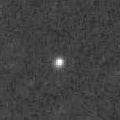
|
Now it is 17.0 mag (Apr. 11, Toshihiko Ikemura, Hirohisa Sato). It is expected to brighten up to 10 mag in 2023. In the Northern Hemisphere, it stays observable in good condition until 2023 autumn. In the Southern Hemipshere, it stays extremely low until mid July, then it becomes unobservable for a while. But it becomes observable in good condition after 2023 summer.
Date(TT) R.A. (2000) Decl. Delta r Elong. m1 Best Time(A, h)
Apr. 17 12 34.44 38 17.4 6.827 7.500 128 16.9 22:51 (180, 87)
Apr. 24 12 29.27 38 37.4 6.840 7.447 123 16.9 22:18 (180, 86)
|
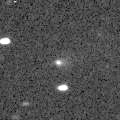
|
First return of a new periodic comet which brightened up to 16 mag in 2014. Now it is 16.0 mag (Apr. 4, Sandor Szabo). It stays observable at 16-17 mag in good condition until July.
Date(TT) R.A. (2000) Decl. Delta r Elong. m1 Best Time(A, h)
Apr. 17 12 21.28 11 35.6 1.327 2.256 150 16.9 22:38 ( 0, 66)
Apr. 24 12 16.16 10 45.1 1.347 2.240 143 16.9 22:05 ( 0, 66)
|

|
Now it is 16.7 mag (Apr. 11, Toshihiko Ikemura, Hirohisa Sato). It will be fading slowly.
Date(TT) R.A. (2000) Decl. Delta r Elong. m1 Best Time(A, h)
Apr. 17 18 19.15 -16 18.0 7.073 7.508 112 16.9 3:56 (347, 38)
Apr. 24 18 15.74 -15 55.7 6.984 7.532 119 17.0 3:46 (353, 39)
|

|
Now it is 17-17.5 mag (Apr. 10, Alan Hale). It will brighten very rapidly, and it will brighten up to 10 mag from July to August. It stays observable in the morning sky for a long time.
Date(TT) R.A. (2000) Decl. Delta r Elong. m1 Best Time(A, h)
Apr. 17 21 26.55 -22 5.6 1.575 1.552 70 17.7 3:56 (307, 11)
Apr. 24 21 51.67 -20 14.4 1.477 1.487 70 17.1 3:46 (305, 11)
|
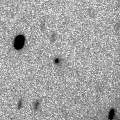
|
Now it is 17.4 mag (Mar. 18, Toshihiko Ikemura, Hirohisa Sato). It will approach to Earth down to 0.2 a.u. in December, and it is expected to brighten up to 4 mag. In the Northern Hemisphere, it stays observable in good condition for a long time until December while the comet is brightening gradually. In the Southern Hemisphere, it is not observable until mid December.
Date(TT) R.A. (2000) Decl. Delta r Elong. m1 Best Time(A, h)
Apr. 17 12 7.24 61 48.6 3.585 3.974 105 17.3 22:23 (180, 63)
Apr. 24 11 48.95 61 46.3 3.580 3.895 100 17.2 21:37 (180, 63)
|

|
First return of a new periodic comet observed at 19 mag in 2015. Now it is 17.8 mag (Mar. 4, Giuseppe Pappa). It will brighten up to 17 mag in early summer, and it will be observable in good condition.
Date(TT) R.A. (2000) Decl. Delta r Elong. m1 Best Time(A, h)
Apr. 17 18 28.55 -11 15.8 0.822 1.493 109 17.3 3:56 (343, 42)
Apr. 24 18 44.02 -11 16.1 0.786 1.492 112 17.2 3:46 (343, 42)
|
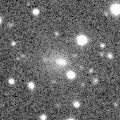
|
Brightened very rapidly up to 15.0 mag (Feb. 4, Michael Jager). Now it is fading. It hasl already faded down to 17.8 mag (Apr. 11, Toshihiko Ikemura, Hirohisa Sato). It is observable in good condition in the Northern Hemisphere. It locates low in the Southern Hemisphere.
Date(TT) R.A. (2000) Decl. Delta r Elong. m1 Best Time(A, h)
Apr. 17 6 7.20 27 35.1 2.320 2.098 64 17.3 20:03 ( 96, 44)
Apr. 24 6 23.61 27 12.0 2.413 2.127 61 17.5 20:10 ( 98, 40)
|

|
Now it is 17.1 mag (Apr. 9, Toshihiko Ikemura, Hirohisa Sato). It brightened rapidly. It stays 17-18 mag for a long time from 2021 to 2022. In the Southern Hemisphere, it stays observable in good condition for a long time. In the Northern Hemisphere, it is observable only until May.
Date(TT) R.A. (2000) Decl. Delta r Elong. m1 Best Time(A, h)
Apr. 17 8 18.37 -7 11.7 5.281 5.556 100 17.5 20:03 ( 30, 43)
Apr. 24 8 16.80 -7 17.5 5.376 5.542 94 17.5 20:10 ( 41, 39)
|
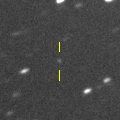
|
Now it is 17.1 mag (Apr. 11, Toshihiko Ikemura, Hirohisa Sato). It stays observable at 17-18 mag for a long time until 2024.
Date(TT) R.A. (2000) Decl. Delta r Elong. m1 Best Time(A, h)
Apr. 17 15 13.42 -10 5.5 8.270 9.202 156 17.5 1:34 ( 0, 45)
Apr. 24 15 9.05 -9 38.9 8.219 9.191 164 17.5 1:02 ( 0, 45)
|

|
Now it is 17.3 mag (Apr. 4, Michael Jager). Fading slowly. In 2021, it stays observable at 17-18 mag in good condition until early summer.
Date(TT) R.A. (2000) Decl. Delta r Elong. m1 Best Time(A, h)
Apr. 17 13 1.83 -16 28.1 5.984 6.972 168 17.5 23:19 ( 0, 38)
Apr. 24 12 59.99 -15 52.6 6.016 6.987 163 17.6 22:49 ( 0, 39)
|

|
It will brighten up to 15 mag from summer to autumn, and it will be observable in good condition. It already locates high in the Southern Hemisphere. It will be getting higher gradually also in the Northern Hemisphere.
Date(TT) R.A. (2000) Decl. Delta r Elong. m1 Best Time(A, h)
Apr. 17 21 31.67 -10 2.8 2.763 2.510 65 17.7 3:56 (297, 19)
Apr. 24 21 42.73 -9 21.1 2.668 2.492 69 17.6 3:46 (298, 20)
|

|
First return of a new periodic comet which brightened up to 13 mag in 2009. It brightened up to 11.7 mag in January (Jan. 10, Marco Goiato). Now it is fading. It has already faded down to 16.9 mag (Mar. 29, Thomas Lehmann). It stays observable in good condition while the comet will be fading after this.
Date(TT) R.A. (2000) Decl. Delta r Elong. m1 Best Time(A, h)
Apr. 17 8 48.00 26 36.4 1.303 1.780 100 17.6 20:03 ( 59, 75)
Apr. 24 9 3.47 25 48.1 1.408 1.827 96 18.0 20:10 ( 65, 71)
|

|
Now it is 17.4 mag (Mar. 14, Toshihiko Ikemura, Hirohisa Sato). It stays 17-18 mag for a long time from 2021 to 2023.
Date(TT) R.A. (2000) Decl. Delta r Elong. m1 Best Time(A, h)
Apr. 17 10 37.87 12 20.5 4.197 4.896 129 17.6 20:55 ( 0, 67)
Apr. 24 10 36.94 12 18.6 4.276 4.889 122 17.6 20:27 ( 0, 67)
|

|
It brightened rapidly up to 16.3 mag in March (Mar. 16, F. Kugel, J.-G. Bosch). Now it is fading. It has already faded down to 18.0 mag (Apr. 11, Toshihiko Ikemura, Hirohisa Sato). It is observable in excellent condition in the Northern Hemisphere. It locates low in the Southern Hemisphere.
Date(TT) R.A. (2000) Decl. Delta r Elong. m1 Best Time(A, h)
Apr. 17 10 40.13 36 3.0 1.752 2.384 117 17.7 20:56 (180, 89)
Apr. 24 10 26.08 38 13.7 1.905 2.408 107 17.8 20:15 (180, 87)
|
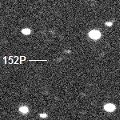
|
Now it is 17.6 mag (Apr. 11, Toshihiko Ikemura, Hirohisa Sato). It will brighten up to 16 mag in 2022. In 2021, it stays observable at 18 mag until September.
Date(TT) R.A. (2000) Decl. Delta r Elong. m1 Best Time(A, h)
Apr. 17 13 40.69 3 28.7 2.428 3.411 166 17.8 0:02 ( 0, 58)
Apr. 24 13 36.21 3 45.3 2.426 3.396 161 17.7 23:25 ( 0, 59)
|
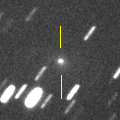
|
It brightened rapidly and became brighter than expected. Now it is 16.9 mag (Mar. 18, Toshihiko Ikemura, Hirohisa Sato). It is observable in good condition in the Northern Hemisphere. It locates somewhat low in the Southern Hemisphere.
Date(TT) R.A. (2000) Decl. Delta r Elong. m1 Best Time(A, h)
Apr. 17 5 56.37 18 48.6 2.394 2.123 62 17.7 20:03 ( 88, 37)
Apr. 24 6 11.29 18 17.8 2.485 2.149 59 17.9 20:10 ( 90, 33)
|

|
Now it is 18.5 mag (Apr. 11, Taras Prystavski). It will brighten up to 9 mag, and will be observable in good condition in winter.
Date(TT) R.A. (2000) Decl. Delta r Elong. m1 Best Time(A, h)
Apr. 17 22 16.99 -14 12.3 2.888 2.471 55 18.0 3:56 (293, 7)
Apr. 24 22 28.69 -13 10.1 2.762 2.418 59 17.8 3:46 (293, 9)
|

|
It stays 17-18 mag for a long time until 2026. In the Southern Hemisphere, it stays sobservable in good condition for a long time. It is not observable in the Northern Hemisphere. Now it is 19.7 mag (Mar. 13, A. C. Gilmore, P. M. Kilmartin), fainter than this ephemeris.
Date(TT) R.A. (2000) Decl. Delta r Elong. m1 Best Time(A, h)
Apr. 17 8 51.54 -55 34.9 11.101 11.461 108 17.8 20:03 ( 8, -1)
Apr. 24 8 49.66 -55 11.3 11.116 11.445 106 17.8 20:10 ( 13, -2)
|
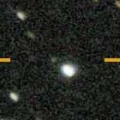
|
Now it is 17.5 mag (Apr. 11, Toshihiko Ikemura, Hirohisa Sato). It is expected to brighten up to 12 mag in 2023. In the Northern Hemisphere, it is observable in good condition in 2021. But it is observable only until November in 2022. In the Southern Hemisphere, it locates extremely low in 2021. But it will be observable in good condition at the high light.
Date(TT) R.A. (2000) Decl. Delta r Elong. m1 Best Time(A, h)
Apr. 17 18 48.99 44 8.3 7.162 7.262 91 17.9 3:56 (231, 73)
Apr. 24 18 47.45 44 39.6 7.065 7.214 94 17.8 3:46 (223, 76)
|

|
Now it is 17.8 mag (Apr. 17, Taras Prystavski). In the Southern Hemissphere, appearing in the morning sky. It is already fading.
Date(TT) R.A. (2000) Decl. Delta r Elong. m1 Best Time(A, h)
Apr. 17 23 11.79 -9 34.0 2.566 1.938 41 17.9 3:56 (281, 0)
Apr. 24 23 26.58 -8 29.5 2.551 1.972 44 18.0 3:46 (281, 1)
|
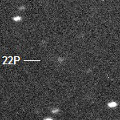
|
Now it is 18.3 mag (Mar. 14, Toshihiko Ikemura, Hirohisa Sato). It will be observable at 11 mag from winter to spring in 2022. In 2021, it is observable until July or August when it brightens up to 16-17 mag.
Date(TT) R.A. (2000) Decl. Delta r Elong. m1 Best Time(A, h)
Apr. 17 10 20.94 14 55.0 2.531 3.209 124 18.0 20:38 ( 0, 70)
Apr. 24 10 19.34 15 0.2 2.580 3.171 117 17.9 20:10 ( 1, 70)
|
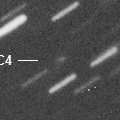
|
Now it is 17.5 mag (Mar. 15, Giuseppe Pappa). It is observable at 18 mag in spring. It is observable in excellent condition in the Southern Hemisphere. It locates low in the Northern Hemisphere.
Date(TT) R.A. (2000) Decl. Delta r Elong. m1 Best Time(A, h)
Apr. 17 13 31.88 -36 2.4 3.638 4.564 154 17.9 23:48 ( 0, 19)
Apr. 24 13 21.04 -34 9.9 3.634 4.573 156 17.9 23:10 ( 0, 21)
|
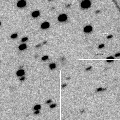
|
Now it is 17.6 mag (Mar. 17, Toshihiko Ikemura, Hirohisa Sato). In the Northern Hemisphere, it stays observable at 18 mag for a long time from 2021 to 2022. It is not observable in the Southern Hemisphere.
Date(TT) R.A. (2000) Decl. Delta r Elong. m1 Best Time(A, h)
Apr. 17 18 9.44 50 12.1 6.909 7.084 95 17.9 3:56 (199, 74)
Apr. 24 18 3.82 51 22.0 6.875 7.083 97 17.9 3:46 (186, 74)
|

|
Now it is 18.6 mag (Apr. 4, Michael Jager). Although it is around the aphelion, it is much brighter than originally predicted.
Date(TT) R.A. (2000) Decl. Delta r Elong. m1 Best Time(A, h)
Apr. 17 10 46.38 10 41.1 4.687 5.411 131 18.2 21:03 ( 0, 66)
Apr. 24 10 44.57 10 41.4 4.776 5.413 124 18.3 20:34 ( 0, 66)
|
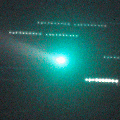
|
It brightened very rapidly in early December, and it brightened up to 10.0 mag in January (Jan. 7, Michael Jager). Now it is fading. However, it brightened in outburst in early March up to 12.9 mag (Mar. 3, Martin Masek). Now it is 16.8 mag (Mar. 31, Thomas Lehmann).
Date(TT) R.A. (2000) Decl. Delta r Elong. m1 Best Time(A, h)
Apr. 17 7 24.95 6 14.0 1.670 1.876 85 19.2 20:03 ( 56, 47)
Apr. 24 7 39.84 6 13.9 1.806 1.945 82 19.8 20:10 ( 61, 43)
|

|
Marsden group's comet. Three apparitions of this comet was confirmed in 1999, 2004 and 2010. It approached to Sun down to 0.044 a.u. on Feb. 28. After the perihelion passage, it may be observed on the ground from March to April.
Date(TT) R.A. (2000) Decl. Delta r Elong. m1 Best Time(A, h)
Apr. 17 20 57.88 -20 49.5 1.155 1.334 75 26.2 3:56 (311, 17)
Apr. 24 20 48.69 -22 21.3 1.142 1.458 85 26.7 3:46 (317, 19)
|
|
![]()
 C/2021 A4 ( NEOWISE )
C/2021 A4 ( NEOWISE ) C/2019 T2 ( Lemmon )
C/2019 T2 ( Lemmon ) C/2018 U1 ( Lemmon )
C/2018 U1 ( Lemmon ) C/2020 F5 ( MASTER )
C/2020 F5 ( MASTER ) C/2021 A7 ( NEOWISE )
C/2021 A7 ( NEOWISE ) 117P/Helin-Roman-Alu 1
117P/Helin-Roman-Alu 1 C/2020 S3 ( Erasmus )
C/2020 S3 ( Erasmus ) 17P/Holmes
17P/Holmes 88P/Howell
88P/Howell C/2017 T2 ( PanSTARRS )
C/2017 T2 ( PanSTARRS ) 156P/Russell-LINEAR
156P/Russell-LINEAR C/2020 M5 ( ATLAS )
C/2020 M5 ( ATLAS ) C/2019 K7 ( Smith )
C/2019 K7 ( Smith ) 201P/LONEOS
201P/LONEOS C/2021 A2 ( NEOWISE )
C/2021 A2 ( NEOWISE ) C/2020 Y2 ( ATLAS )
C/2020 Y2 ( ATLAS ) C/2018 N2 ( ASASSN )
C/2018 N2 ( ASASSN ) C/2020 H6 ( ATLAS )
C/2020 H6 ( ATLAS ) C/2020 S8 ( Lemmon )
C/2020 S8 ( Lemmon ) C/2017 Y2 ( PanSTARRS )
C/2017 Y2 ( PanSTARRS ) C/2019 T3 ( ATLAS )
C/2019 T3 ( ATLAS ) C/2020 M3 ( ATLAS )
C/2020 M3 ( ATLAS ) C/2020 N1 ( PanSTARRS )
C/2020 N1 ( PanSTARRS ) C/2020 O2 ( Amaral )
C/2020 O2 ( Amaral ) 409P/2020 V1 ( LONEOS-Hill )
409P/2020 V1 ( LONEOS-Hill ) C/2019 O3 ( Palomar )
C/2019 O3 ( Palomar ) C/2019 U5 ( PanSTARRS )
C/2019 U5 ( PanSTARRS ) C/2020 V2 ( ZTF )
C/2020 V2 ( ZTF ) 413P/2020 W4 ( Larson )
413P/2020 W4 ( Larson ) C/2017 U7 ( PanSTARRS )
C/2017 U7 ( PanSTARRS ) 15P/Finlay
15P/Finlay C/2021 A1 ( Leonard )
C/2021 A1 ( Leonard ) 417P/2021 B1 ( NEOWISE )
417P/2021 B1 ( NEOWISE ) P/2020 U2 ( PanSTARRS )
P/2020 U2 ( PanSTARRS ) C/2020 F7 ( Lemmon )
C/2020 F7 ( Lemmon ) C/2020 F2 ( ATLAS )
C/2020 F2 ( ATLAS ) C/2019 C1 ( ATLAS )
C/2019 C1 ( ATLAS ) 284P/McNaught
284P/McNaught 398P/2020 P2 ( Boattini )
398P/2020 P2 ( Boattini ) 99P/Kowal 1
99P/Kowal 1 C/2021 C3 ( Catalina )
C/2021 C3 ( Catalina ) 152P/Helin-Lawrence
152P/Helin-Lawrence 277P/LINEAR
277P/LINEAR 67P/Churyumov-Gerasimenko
67P/Churyumov-Gerasimenko C/2019 E3 ( ATLAS )
C/2019 E3 ( ATLAS ) C/2020 K1 ( PanSTARRS )
C/2020 K1 ( PanSTARRS ) 98P/Takamizawa
98P/Takamizawa 22P/Kopff
22P/Kopff C/2021 C4 ( ATLAS )
C/2021 C4 ( ATLAS ) C/2016 Q2 ( PanSTARRS )
C/2016 Q2 ( PanSTARRS ) 47P/Ashbrook-Jackson
47P/Ashbrook-Jackson 141P/Machholz 2
141P/Machholz 2 P/1999 J6 = P/2004 V9 = P/2010 H3 ( SOHO )
P/1999 J6 = P/2004 V9 = P/2010 H3 ( SOHO )![]()




























































